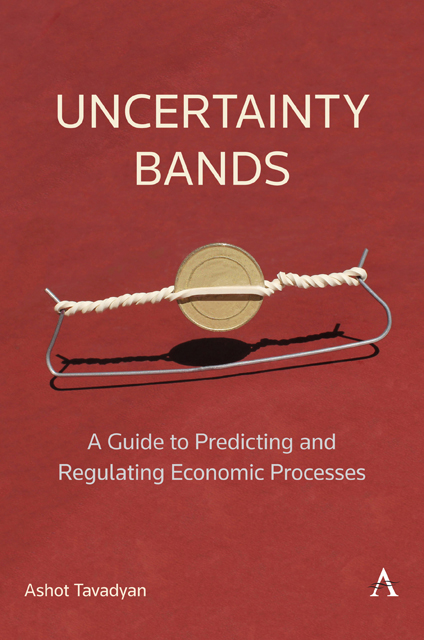Book contents
- Frontmatter
- Contents
- Preface
- Introduction: The Philosophy of Economic Forecasting
- 1 Interval Links in Economy and the Capabilities of Quantitative Thinking
- 2 The Possibilities for Forecasting Economic Indicators
- 3 The Principle of the Minimal Uncertainty Interval
- 4 The Intervals of Key Economic Indicators
- 5 Key Principles of Economic Regulation
- Conclusion
- Appendix: The Uncertainty Relations of Economic Indicators
- Acknowledgments
- Index
5 - Key Principles of Economic Regulation
Published online by Cambridge University Press: 09 December 2022
- Frontmatter
- Contents
- Preface
- Introduction: The Philosophy of Economic Forecasting
- 1 Interval Links in Economy and the Capabilities of Quantitative Thinking
- 2 The Possibilities for Forecasting Economic Indicators
- 3 The Principle of the Minimal Uncertainty Interval
- 4 The Intervals of Key Economic Indicators
- 5 Key Principles of Economic Regulation
- Conclusion
- Appendix: The Uncertainty Relations of Economic Indicators
- Acknowledgments
- Index
Summary
Economic Diseases Caused by Regulation
Consequences of fragile stability
Achieving sustainable price stability is problematic without considering the causal links of prices with the entire financial system. The need to consider those links becomes increasingly evident after each financial and economic crisis. Low inflation, which is artificially achieved by increasing the bank rate, will be accompanied by high reserve requirement, restrained exchange rate, depletion of foreign exchange reserves and high interest rates for government bonds. In those conditions, the seemingly stable annual inflation is followed by unreasonably high real bank rate, seasonal and structural substantial price fluctuations, the decline in GDP growth rate, deterioration of its structure and a decrease in the growth of exports. Even with seemingly stable low inflation, those characteristics certainly are not reminiscent of financial stability, making the very process of ensuring price stability ineffective.
Under those conditions the penalty for artificially low inflation is high, and the risk of its sudden leap increases even from minor changes in the world economy. Paradoxically, low inflation, in that case, becomes very fragile. Extra-systemic price stability arises. Hence, the contradiction between price stability and financial stability may result in sudden price fluctuations, especially for the most sensitive prices of essential goods.
In transforming economies inflation below 2 percent or above 5 percent is usually accompanied by a significantly high real bank rate, which is more than 2 percent. Moreover, a high real bank rate may substantially push up the risk of uncontrollable inflationary processes. Those bounds represent estimated sensitivity thresholds for inflation.
Exiting the marked interval about the interconnected key economic indicators will stipulate the occurrence of the following economic diseases:
1. A decline in economic growth, deterioration of its structure;
2. Decrease in exports;
3. Reduction of foreign exchange reserves;
4. Growth of public debt, mostly external;
5. Inadequately low monetization ratio;
6. Seemingly stable exchange rate, which is not conducive to GDP growth or improvement of its structure.
The smaller the attainable interval for inflation, the more it contributes to economic predictability and development. Thus, it is better to have sustainable and predictable inflation between 2 percent and 5 percent, that is, an interval of no more than 3 percentage points, than to aim for inflation below 2 percent with a probability of a sudden leap in this indicator.
- Type
- Chapter
- Information
- Uncertainty BandsA Guide to Predicting and Regulating Economic Processes, pp. 63 - 78Publisher: Anthem PressPrint publication year: 2022



